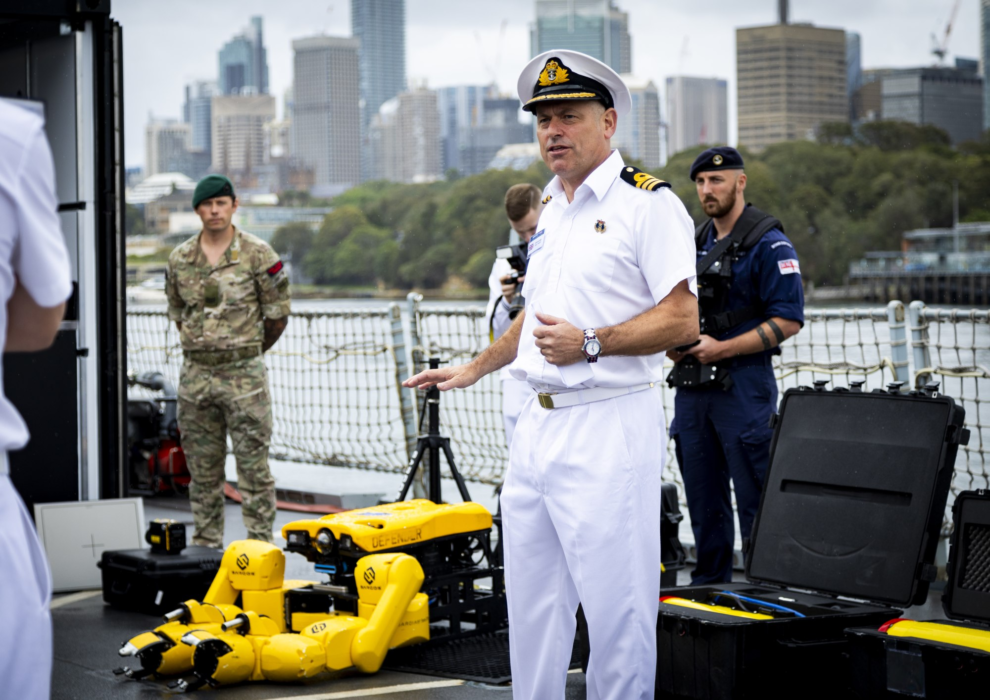The United Kingdom, the United States, and Australia have tested new uncrewed undersea capabilities as part of the AUKUS partnership.
Australia’s undersea support vessel, Australian Defence Vessel Guidance, hosted a range of new uncrewed undersea vessels while at sea during the exercise as well as international representatives, including UK Deputy Chief of the Defence Staff for Military Capability Lieutenant General Rob Magowan.
The exercise is designed to increase the protection of critical underwater infrastructure.
The ADV Guidance’s primary role is to support undersea and surveillance systems trials and includes the ability to host a small team of sailors as well as onboard and offboard systems, with both crewed and uncrewed capability.
“The recent AUKUS trials and exercise demonstrate the advances being made possible by our trilateral collaboration under the partnership,” according to First Sea Lord Admiral Sir Ben Key, who visited Australia to address the Australian Sea Power Conference.
“It is hugely exciting to see the strength of our three nations, coming together through the AUKUS partnership to successfully develop and demonstrate a range of underwater capabilities that are crucial to ensuring safety and security in the region and more broadly.
“AUKUS is a landmark security and defence partnership between Australia, the UK, and the US to support a free and open Indo-Pacific by strengthening regional global security. This exercise is a significant step forward for delivery of the undersea warfare capabilities work stream under the second pillar of AUKUS.
“AUKUS Pillar 2 seeks to strengthen trilateral capabilities in cutting-edge military technologies, increase interoperability, and drive knowledge-sharing and innovation. AUKUS partners are developing a suite of advanced capabilities including autonomous systems, artificial intelligence, and other key technologies for the three AUKUS nations. Pillar 2 complements trilateral efforts under AUKUS Pillar 1 to deliver a conventionally-armed nuclear-powered submarine capability to Australia.”
The United Kingdom’s offshore patrol vessel HMS Tamar, which is on a five-year deployment to the Indo-Pacific, also played a key role in the exercise.
HMS Tamar used a combination of divers and autonomous underwater vehicles to conduct mine countermeasure operations and monitor critical infrastructure, including pipelines and communications cables.
“Submarines are critical to the defence of Australia. Our submarines, and other military assets, will increasingly work with autonomous systems below and on the surface of the ocean to extend range and lethality,” according to Royal Australian Navy Chief of Navy, Vice Admiral Mark Hammond.
“AUKUS Pillar Two is about delivering advanced capabilities, including through technologies that extend reach and range.
“As we have seen in the Ukraine conflict, scalable autonomous and semi-autonomous systems have the capacity to transform warfighting. The Defence Strategic Review (DSR) identified asymmetric capabilities like these as critical in the defence and protection of the nation.
“These technologies originate from a range of industries, like the off-shore oil and gas and communications industries. They have been modified to carry a military payload to become force multipliers, working in concert with our ships, submarines and aircraft, and to serve as a key deterrent.
“What we get by working with industry in this way is speed, what we get by doing it together under the AUKUS partnership is scale, where the sum of the whole is greater than its parts.”
US Navy Pacific Fleet Commander Admiral Samuel Paparo said AUKUS nations are prioritising capabilities that improve a warfighter’s ability to see, understand, decide and act, then work together to bolster integrated deterrence.
“These exercises accelerate our combined development of advanced military capabilities. In a dynamic strategic environment and the escalation of competitors’ coercive activities, AUKUS is not just about the exchange of submarines and capabilities, it is an expansion of our continued trust in and commitment to our allies,” ADM Paparo said.
“Australia, the United Kingdom, and the United States are developing and fielding joint advanced military capabilities to promote security and stability in the Indo-Pacific region. The strategic alignment of our national defence strategies, anchored by shared values, is driving unprecedented collaboration in advanced technologies.
“Our trilateral exercises develop and deliver interoperable, threat-informed capabilities key to the warfighter, and contribute to sustained defence industrial-based collaboration. Meanwhile, the AUKUS partners are investing in trilateral projects that are enhancing our scientific and technological capacity to build enduring advantages for the future.”
Earlier this month, the Australian Deputy Prime Minister joined the UK Defence Secretary Grant Shapps on a visit to Rolls-Royce in Derby – the location where the nuclear reactors will be built for the SSN-AUKUS submarines under the AUKUS collaboration.
Source : DefenceConnect






































